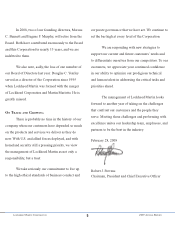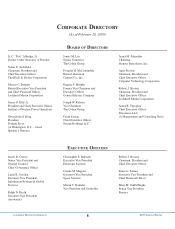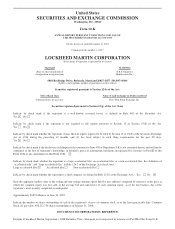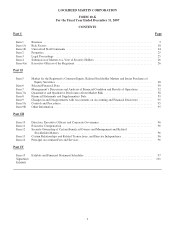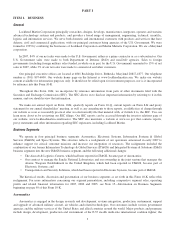Lockheed Martin 2007 Annual Report Download - page 17
Download and view the complete annual report
Please find page 17 of the 2007 Lockheed Martin annual report below. You can navigate through the pages in the report by either clicking on the pages listed below, or by using the keyword search tool below to find specific information within the annual report.
In 2007, Electronic Systems’ net sales of $11.1 billion represented 27% of our total net sales. Electronic Systems’ three
major lines of business and the percentage that each contributed to 2007 net sales are:
Maritime Systems & Sensors
Missiles & Fire Control
Platform, Training, & Energy
41%
22% 37%
The segment is dependent on both military and civilian agencies of the U.S. Government as well as international
governments as customers. In 2007, U.S. Government customers accounted for approximately 74% of the segment’s total net
sales.
Maritime Systems & Sensors
Maritime Systems & Sensors (MS2) provides ship systems integration services, including command, control,
communications, computers, intelligence, surveillance and reconnaissance (C4ISR) capability across shore-based command
centers; surface ship and submarine combat systems, sea-based missile defense systems; sensors; tactical avionics; port
traffic management systems; missile launching systems; aerostat surveillance systems; and supply chain management
programs and systems.
The AEGIS weapon system is a fleet defense system and a sea-based element of the U.S. missile defense system. It is a
radar and missile launching system, integrated with its own command and control system, designed to defend against
advanced air, surface and subsurface threats. The AEGIS program encompasses activities in development, production, ship
integration and test and lifetime support for ships of the U.S. Navy and international customers. We test and integrate these
weapon systems for the U.S. Navy’s Ticonderoga class cruiser and Arleigh Burke class destroyer, along with the Kongo class
destroyer for Japan, the F100 and F105 class frigates for Spain, the Fridtjof Nansen class frigate for Norway, the KDX class
destroyer for Korea and the Hobart class air warfare destroyer for Australia. Since program inception in 1978, MS2 has
received contracts for 111 AEGIS weapons systems, including 27 for the Ticonderoga class cruiser, 62 for the Arleigh Burke
class destroyer and 22 international systems. During 2007, our production workscope included four international systems and
three domestic systems.
In 2007, the DoD’s Missile Defense Agency (MDA) awarded MS2 a contract for continued development and evolution
of the AEGIS Ballistic Missile Defense System (BMDS). There are 18 ships planned with BMDS technology and long-range
surveillance and tracking capability. During the year, we performed a number of successful ballistic missile intercept tests.
The latest test achieved an unprecedented result in which the BMDS successfully intercepted and destroyed two
non-separating ballistic missile targets nearly simultaneously.
In early 2007, we were awarded a program to manage the logistics and warehousing for all tires used on U.S. Air Force
and Army aircraft around the world, supporting the tire manufacturer and prime contractor on the program. This performance
based contract will leverage our global supply chain management expertise as the U.S. military seeks to integrate the
production and the logistics for aircraft tires.
The U.S. Navy has approved a revised ship delivery date of August 2008 for the Littoral Combat Ship Freedom
(LCS-1), the first in a new class of ships designed to provide added flexibility to operate in coastal waters. Delivery is to be
followed by a 60-day crew move aboard period in order to complete ship load-out activities and conduct ship crew
familiarization training. At the end of 2007, the ship was over 80% complete, with compartment closeout and system testing
proceeding. Our production activities continue to focus on preparing for a series of dockside tests in support of builder’s sea
9


